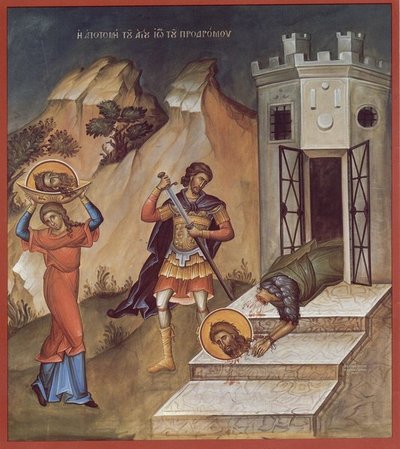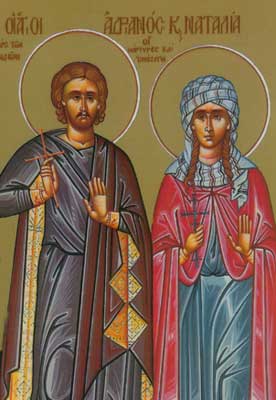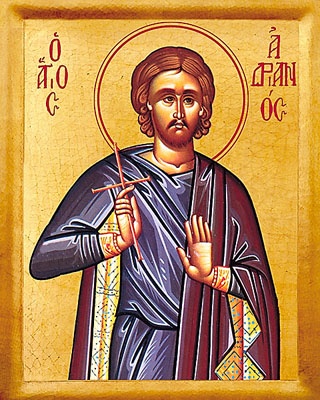https://aidanharticons.com/st-aidan-3/
https://aidanharticons.com/saint-aidan-of-lindisfarne-2/
https://aidanharticons.com/st-aidan-with-scenes/
http://groups.yahoo.com/group/celt-saints/message/3162
L'évêque
Aedan est né en Irlande à la fin du 6ème siècle, et mourut en 651.
Saint Aidan fut disciple de saint Senan (8 mars) sur l'Ile Scattery,
mais on ne sait rien de plus de certain sur sa vie antérieure à son
entrée comme moine à Iona. Il fut bien accueillit par le roi saint
Oswald (9 août), qui avait vécut en exil parmi les moines Irlandais à
Iona et y avait demandé des moines pour évangéliser son royaume. Le
premier missionnaire, Corman, n'eut pas de succès à cause de la rudesse
de ses méthodes; dès lors Aidan fut envoyé pour le remplacer. Oswald
accorda l'île de Lindisfarne ("Ile sainte") à Aidan pour y fonder son siège épiscopal; son diocèse s'étendra du Forth jusqu'à l'Humber
Par
ses actions, il montra que jamais il ne chercha ni n'aima les biens de
ce monde; les présents que le roi ou les riches lui offraient, il les
donnait aux pauvres. Il vint rarement à la table royale, et jamais sans y
emmener l'un ou l'autre de son clergé, et se hâtant toujours de quitter
pour rejoindre ses tâches. Le centre de son activité était Lindisfarne,
au large de la côte du Northumberland, entre Berwick et Bamburgh. Là,
il établit un monastère sous la Règle de saint Columcille (Columba d'Iona);
il n'était pas inapproprié de l'appeler l'Iona anglais, parce que de
là, le paganisme fut progressivement éliminé en Northumbrie et les
coutumes barbares sapées. La communauté n'était pas autorisée à
accumuler des richesses;
les surplus étaient utilisés pour les besoins des pauvres et le rachat
avec affranchissement des esclaves (manumission). De Lindisfarne, Aidan
voyagea à pied à travers le diocèse, visitant son troupeau et fondant
des centres missionnaires.
L'apostolat d'Aidan fut facilité par des
miracles innombrables, rapportés par saint Bede (25 mai) qui rédigea sa
biographie. Il fut aussi aidé par le fait qu'Aidan prêcha en Irlandais
et que le roi fit la traduction. Saint Aidan fit entrer 12 jeunes
Anglais dans son monastère, pour les y élever, et il était infatigable
pour s'occuper du bien-être des enfants et des esclaves, et pour
l'affranchissement de ces derniers, il utilisa pour leur manumission
nombre des aumônes qu'on lui accorda.
Le grand roi saint Oswald
assista son évêque de toutes les manières possibles jusqu'à sa mort à la
bataille contre le roi païen Penda en 642. Une belle histoire préservée
par saint Bède nous rapporte
qu'Oswald était attablé pour dîner un jour de Pâques, saint Aidan à ses
côtés, quand on lui apprit qu'un grand groupe de pauvres demandait
l'aumône à la porte. Prenant un plat en argent massif, il le chargea
avec la viande de sa propre table et ordonna de la distribuer parmi les
pauvres, puis qu'on brisa le plat d'argent et qu'on en partagea les
morceaux entre les pauvres. Aidan, nous dit Bède, prit la main droite du
roi, disant "Que jamais cette main ne périsse!" Sa bénédiction
s'accomplit. Après la mort d'Oswald, son bras droit incorrompu fut
conservé comme sainte relique.
Saint Oswin (20 août), le successeur
de saint Oswald, soutint aussi l'apostolat d'Aidan. Et lorsqu'en 651,
Oswin fut assassiné par Gilling, Aidan ne lui survécut que 11 jours. Il
mourût au château royal de Bamburgh, qu'il utilisait comme centre
missionnaire, gisant contre un mur de l'église où une tente avait été
dressée pour l'abriter. Il fut d'abord
enterré dans le cimetière de Lindisfarne, mais quand la nouvelle église
Saint-Pierre fut achevée, on y transféra son corps. Les moines de
Lindisfarne, fuyant les attaques répétées des Vikings, abandonnèrent
leur sainte île en 875, emportant les reliques de saint Oswald et saint
Aidan placées dans le cercueil contenant le corps incorrompu de saint
Cuthbert. Durant 100 ans, les moines errèrent, s'installant de ci de là,
et fondant des églises. En 995, craignant une nouvelle attaque des
envahisseurs Danois, les moines s'enfuirent à nouveau avec leurs
précieuses reliques. Selon la tradition, quand les moines approchèrent
de la ville de Durham, le cercueil devint de plus en plus lourd, et un
moine eut un songe dans lequel Cuthbert dit que son corps trouverait son
repos final à "Dunholme". Aucun des moines ne connaissait un tel lieu
mais, interrogeant les villageois, ils entendirent 2 femmes parler d'une
vache perdue qui se serait égarée
dans "le Dunholme". Les moines investiguèrent ce détail et découvrirent
que c'était un promontoire boisé sur une boucle de la Rivière Wear, où
de nos jours se trouve la cathédrale de Durham.
Les moines de
Glastonbury affirmèrent que dès le 11ième siècle, ils possédaient les
ossements de saint Aidan de Lindisfarne (Northumberland). Nous savons
que ce n'était pas le corps entier, car il est reconnu que la moitié du
corps se trouve à Iona en Écosse, et une partie du restant se trouve à
la cathédrale de Durham. Saint dont le corps n'était pas entier et
pourtant le plus ancien enregistré, il semble qu'Aidan est le seul saint
"nordique" dont les reliques furent amenées au sud à Glastonbury par
Tyccea, bien qu'apparemment pas sous la menace Viking.
Saint Bède
loue hautement l'Irlandais Aidan qui fit tant pour porter l'Évangile à
ses frères Anglo-Saxons. "Jamais il ne rechercha ni n'aima quoique ce
soit de ce monde, mais fit ses
délices à distribuer immédiatement aux pauvres quoique ce soit que rois
ou riches du monde lui donnèrent. Il traversa villes et pays à pied,
jamais à cheval, sauf si pressé par une urgente nécessité. Partout où il
rencontrait quelqu'un, riche ou pauvre, il l'invitait, si païen, à
embrasser le mystère de la Foi; ou s'il s'agissait d'un croyant, il
cherchait à le renforcer dans leur Foi, exhortant par des paroles et
actions pour les aumônes et bonnes oeuvres."
Il écrivit que saint
Aidan "était un homme d'une gentillesse remarquable, bon et modéré, zélé
pour Dieu; mais pas complètement selon la connaissance..." Par cela,
Bède veut dire qu'Aidan suivait et enseignait la Liturgie et les
coutumes disciplinaires des Chrétiens Celtes, qui différaient de ceux de
la Chrétienté continentale romaine. Montague note qu'un des efforts de
l'éducation anglo-saxonne dirigée par les moines Irlandais était que
l'écriture anglaise se
distinguait par son orthographe irlandaise. Aidan amena en Irlande la
coutume du jeûne du mercredi et du vendredi (voir Didachè).
Dans
l'art, on représente Saint Aidan en évêque avec en main le monastère de
Lindisfarne et un cerf à ses pieds (parce que la tradition rapporte que
sa prière rendit invisible un cerf poursuivit par des chasseurs). Il
peut aussi être représenté
(1) tenant une torche allumée;
(2) donnant un cheval à un pauvre;
(3) calmant une tempête; ou
(4) éteignant un incendie par sa prière. Il est particulièrement vénéré à Glastonbury, Lindisfarne, et Whitby
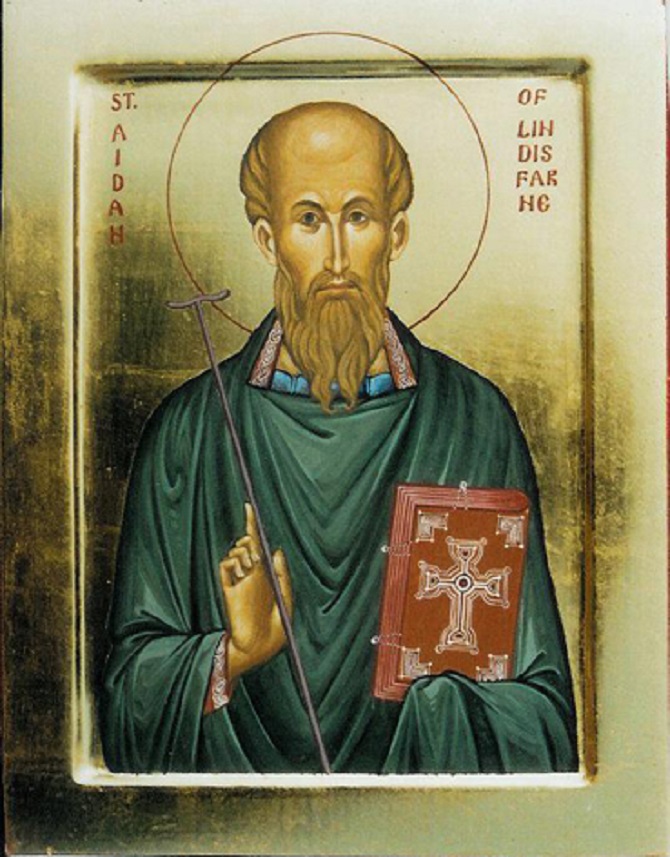
Office à notre père parmi les Saints Aidan, évêque de Lindisfarne, Illuminateur de la Northumbrie (en anglais) :http://orthodoxengland.org.uk/servaida.htm
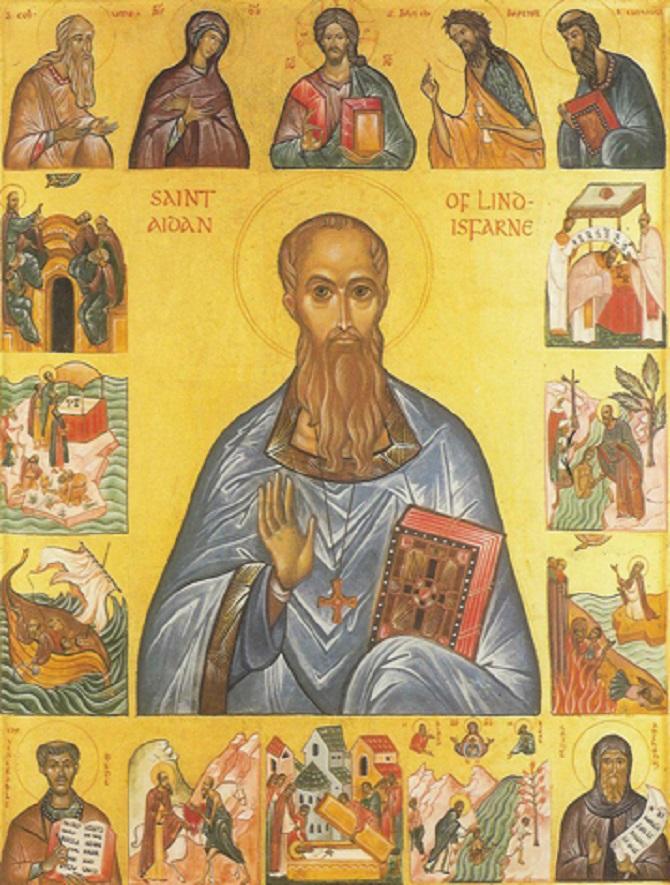
ancienne fresque de saint Aidan
Tropaire de Saint Aidan ton 5
O saint évêque Aidan,
Apôtre du Nord et luminaire de l'Église Celtique,
Glorieux en humilité,
Noble dans la pauvreté,
Moine zélé et missionnaire plein d'amour,
Intercède pour nous pécheurs
Afin que le Christ notre Dieu accorde Miséricorde à nos âmes.
récits d'un pèlerinage à Lindisfarne ("Holy Island") et Durham (en anglais)
St Aidan and St Chad

Leave me alone with God as much as may be.
As the tide draws the waters close in upon the shore,
Make me an island, set apart,
alone with you, God, holy to you.
Then with the turning of the tide
prepare me to carry your presence to the busy world beyond,
the world that rushes in on me
till the waters come again and fold me back to you.
Aidan of Lindisfarne



